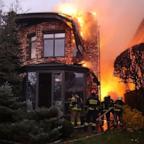
Fighting for the rural vote
In 2016 and 2020, Trump helped solidify a relatively new trend in American politics: Cities, suburbs and more-urban states became increasingly blue, while rural areas and largely rural states became more solidly red. Trump inspired higher turnout and secured larger victories in rural areas in both elections, improving on 2012 Republican nominee Mitt Romney's performance in those areas. When Biden won in 2020, it was largely because he did even better in urban areas than Hillary Clinton had four years before.
This year, the Harris campaign has tried to lure some of those rural voters away, especially with its vice-presidential choice. Minnesota Gov. Tim Walz hails from small-town Nebraska, and has presented a folksy Midwestern, neighbors-helping-neighbors view of rural life — and played up his record supporting farmers in Congress and as governor of Minnesota, a relatively rural state with a major agriculture industry. Walz has talked about being a hunter and gun owner, and a picture of him holding a piglet went viral soon after he was picked for the VP slot. (Not without criticism from progressives over his support of factory farms: Minnesota is a hog farming state.)

Of course, the Harris campaign isn't just deploying Walz. They're reaching out to voters in rural swing states like Wisconsin and North Carolina. In Pennsylvania, they're trying to learn from Sen. John Fetterman's strategy of mobilizing college students to vote to shore up support in rural counties. One study from the University of New Hampshire found that Democrats could tip northern swing states by winning just 3% more of the vote in rural communities.
Walz has at times contrasted his rural, small town background directly with that of Sen. JD Vance, Trump's running mate, who is often mistakenly thought of as being from Appalachia because of his book, Hillbilly Elegy. Vance's hometown, Middletown, Ohio, is in fact a small city of about 50,000 in the Cincinnati metropolitan area, which is not considered part of the region. His connection to Appalachia is more cultural: His grandparents were from Eastern Kentucky, and his book recounts his family's struggles with poverty and drug addiction. Vance represents a different kind of swing-state voter, those from the Rust Belt Midwest, and the Trump campaign has deployed him in similar fashion to Walz in states like Michigan and Pennsylvania — though he spent much of his adult career, after Yale Law School, in Silicon Valley. In early polling, Vance wasn't a popular pick with many voters wherever they lived, and his elevation to VP candidate even prompted a spate of think pieces calling his Appalachian and rural credentials into question — though his relatively solid debate performance may have redeemed him in some eyes.

Rural voters make up only 14% of the electorate. And voters aren't typically swayed by vice-presidential candidates. But in such a tight race, small shifts in any group of voters might be enough to make a difference, and the choices of Walz and Vance show how much these voters still matter to both parties.







